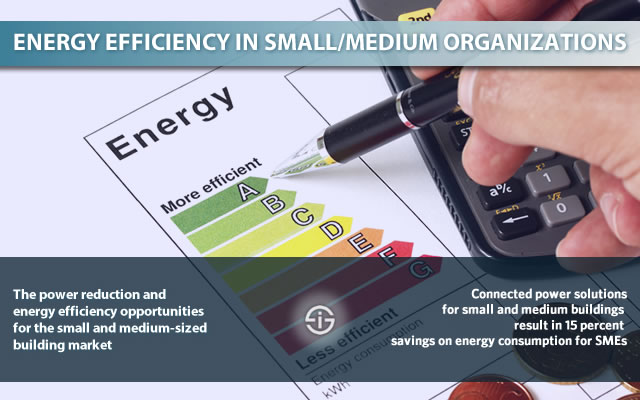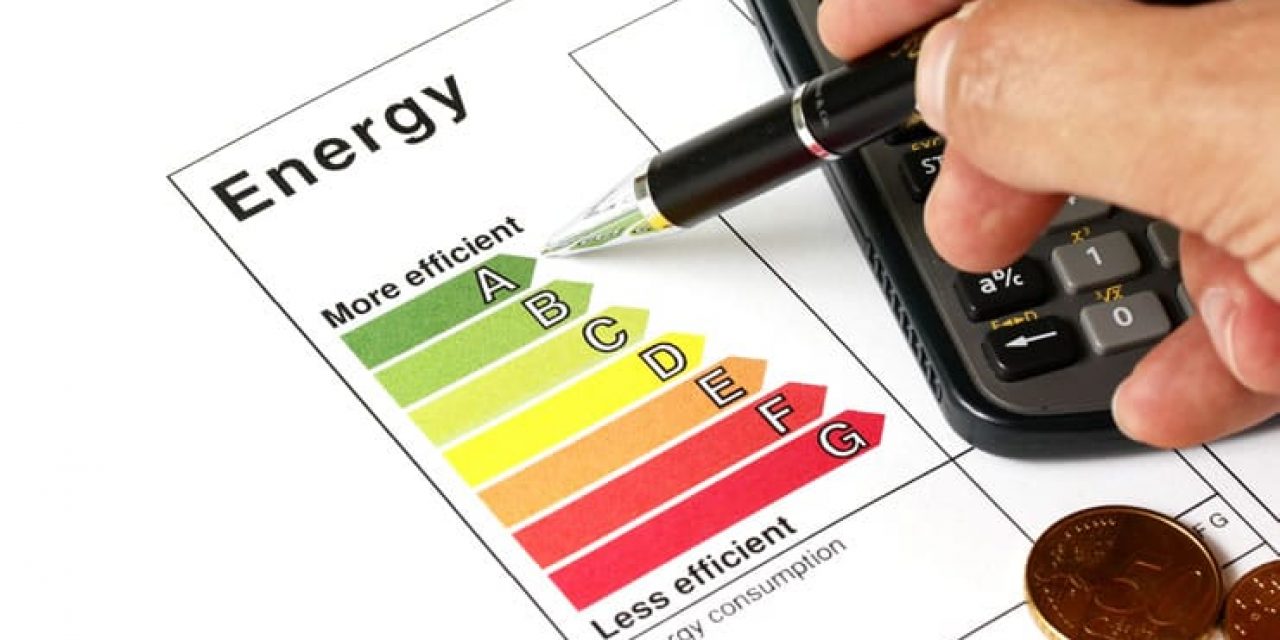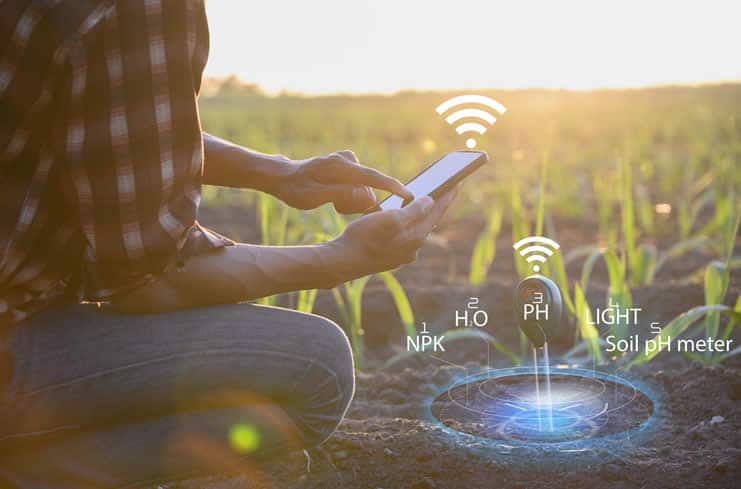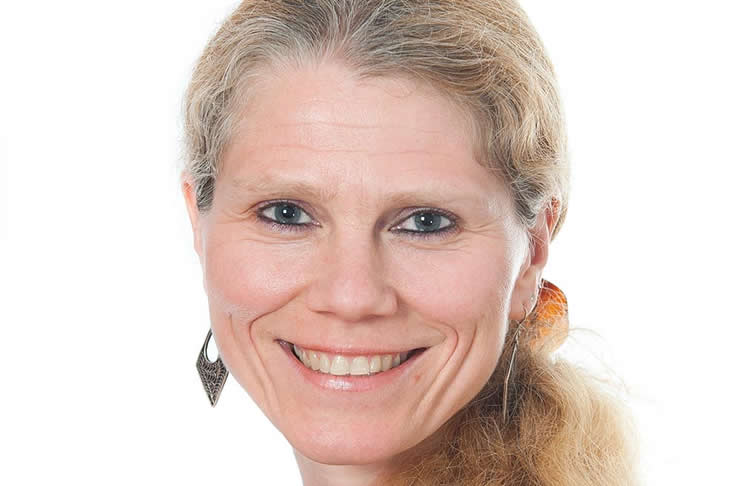Energy efficiency is often mentioned in a context of energy accounting in critical power buildings, in the broader scope of smart buildings or in a context of realizing energy efficiencies in smart home automation.
However, the large majority of companies are small and medium business, which aren’t just key for the economy but also dispose of smaller to medium buildings where ample energy efficiency optimization opportunities exist that, if added up, are pretty significant.
On top of traditional energy efficiency enhancement measures such as good insulation, moving to more energy-efficient forms of light, working with certified energy-friendly electrical equipment and electronics and, equally important, working with electrical contractors that have know-how with regards to energy efficiency, new technologies such as the Internet of Things (IoT) offer better and smarter energy efficiency approaches than ever before.

The role of intelligent, end-to-end electrical distribution and energy management in energy efficiency optimization
In fact, according to Enrique Birlanga, who is responsible for the EcoXpert Connected Power certification badge of Schneider Electric’s awarded partner program, which mainly addresses electrical contractors and smaller to medium buildings, connected power solutions alone already result in 15 percent savings on energy consumption for SMBs (small and medium businesses) or SMEs (small and medium-sized enterprises if you prefer).
Connected Power EcoXperts need to have “proven expertise in delivering connected electrical distribution systems in non-critical buildings, that enable measurement and manages connectivity to improve the overall operations and deliver optimized energy savings”. It’s energy efficiency for small and medium buildings, leveraging the latest connected power technologies such as the Internet of Things, cloud computing and data analytics.

Such intelligent data-driven power solutions and building management systems are used in large buildings but increasingly also find their ways into smaller and medium buildings as the call for energy efficiency, energy savings and being in line with an increasing number of regulations gets louder. Do note that energy efficiency is also a key driver in the use of IoT in building management and in applications in home automation.
Energy efficiency, in the sense of both reducing the amount of energy needed and avoiding losses in a pro-active way (cost avoidance), can be achieved in many ways in small to medium-sized buildings.
In the mentioned Connected Power certification badge context, for instance, it’s mainly about intelligent electrical distribution, smart electricity panels (essentially enabling the electrical equipment to communicate data), smart metering and energy management with a cloud monitoring and control application for low-voltage environments.
These types of systems and solutions are end-to-end, all the way from adding intelligence to the distribution board or electrical panel in the smaller and medium building, to the management systems in the cloud that give the building owner and the electrical contractor much needed data on the electrical energy efficiency overall.
As Enrique Birlanga pointed out this doesn’t just improve energy efficiency in the building, it also provides ways for electrical contractors to move beyond a “design, install and go” business model in which they find themselves now.
Although more and more small to medium building owners seek such solutions, the lesser known technological IT aspects scare some electrical contractors off and puts them in a danger zone as market demand grows.
Energy efficiency in small to medium-sized buildings: the role of light control, room control and HVAC
Moreover, with the wealth of current – mentioned – certification programs and the ease of use of connected power solutions, there aren’t too much excuses left not to take that step due to technology-related concerns which one by one have been proven wrong. And we even haven’t mentioned energy efficiency regulations yet.
Other energy efficiency optimization solutions for small and medium buildings exist in different building management areas such as light control, room control, ventilation and heating (HVAC) and so forth. In the end, it is all connected.
It is one of the reasons why, according to Jean Commeignes, who is responsible for the L&RC certification badge within the EcoXpert program, says that nothing stops electrical contractors or specialized system integrators to go for a cross-certification approach and acquire the skills needed to enhance energy efficiency on all possible levels within the small and medium building space. As Jean puts it in our interview on light control, room control and the Internet of Things: “You can imagine that a Connected Power EcoXpert who is strong in electrical switchboards, power metering and smart panels, sees the market opportunity of his customers increasingly demanding all-in-one smart systems”.

They could easily move beyond smart connected power with, among others, the monitoring of electrical distribution to offer more energy saving and energy efficiency possibilities, in combination with other benefits of lighting control and room control such as comfort.
That brings us to the question what a smaller to medium sized building in this scope really is. You can imagine the typical building of a many types of SMEs but we also talk about smaller offices, restaurants, retail stores and so much more, each of which are different and each of which offer energy saving and energy efficiency opportunities.
The power reduction and energy efficiency opportunities for the small and medium-sized enterprise market
To quote from a publication (PDF opens) of the U.S. Department of Energy, small buildings equal big opportunities for energy saving and at the same time small buildings equal big energy use (with the large majority of commercial buildings being smaller than 50,000 ft² and consuming 44 percent of overall energy use in buildings).
In many countries the number of small buildings and small to medium businesses is even much higher. Several EU countries, for instance, are typically known as SMB economies. Often these countries are also subject to energy performance and energy efficiency regulations. As a matter of fact, the EU council announced its position on a proposal to revise the directive on the energy performance of buildings as recent as end June 2017. And in October 2017 the amendments to the revised Energy Performance of Buildings Directive (EPBD) were approved. In Europe alone, the market of energy efficient building technology (both residential and commercial buildings) is worth over 83 Billion USD, with more growth predicted.
SMBs or SMEs don’t just benefit by focusing more on energy efficiency, they will also be required to and that means their partners, whether it concerns electrical distribution, heating systems, renovations and so forth, will need to be able to help them meet these requirements.
In 2015 the International Energy Agency published a document (PDF opens) with regards to the acceleration of energy efficiency in small and medium-sized enterprises or SMEs.
Emphasizing the key role of SME’s in the global economy (99 percent of enterprises and good for 60 percent of employment) and the collective energy demand of all SMEs (over 13 percent of total global energy demand), the document states that cost-effective energy efficiency measures can reduce energy consumption up to 30 percent.
While that might seem small (30% of 13% of all global energy demand) the report puts that number in perspective: it’s more than all energy consumed by Japan and Korea per year (!).
According to more recent data from the U.S. Department of Energy, U.S. Department of Energy, overall by 2030, building energy use could be cut more than 20 percent using energy efficiency technologies which are known to be cost effective today and by more than 35 percent if research goals are met. The report mainly looks at heating, ventilation, air conditioning, lighting, major appliances and a mix of other areas across all building types in the U.S. That is pretty close to the 30 percent of the International Energy Agency with regards to SMEs.
Energy efficiency for small and medium businesses: looking beyond cost savings
Obviously, energy consumption reductions of up to 30 percent as a result of energy efficiency measures doesn’t mean individual small and medium-sized organizations can reduce consumption in the same way as
- they all have different needs and activities, while operating in different contexts, and
- reduction of energy consumption doesn’t necessarily translate in energy cost savings.
SMEs will need to do some investments and look at the overall TCO and ROI of implementing energy efficiency measures and solutions, which lead to gains, for instance with regards to cost avoidance and even the creation of additional revenues. By way of a simple example with regards to the latter: customer expectations have changed all across the board and, for instance, in retail, the need for energy efficiency and redesign can go hand in hand with an enhanced level of comfort as offered by lighting and room control and myriad applications that offer more immersive shopper experiences and respond better to modern customer expectations. This can easily be applied in other areas such as restaurants and fast food chains too (just compare the level of technological possibilities and connected applications for customers and staff in many larger fast-food chains – whereby each location is a small building – in comparison with just a few years ago).
The growing role of smart technologies in energy efficiency for small to medium-sized buildings
Obviously there isn’t such a thing as a universally valid list of ways to enhance energy efficiency in small and medium buildings.
Some measures might overlap with what we see in critical power buildings, others might overlap with energy efficiency best practices in a smart home automation context and some might be specific for a certain type of small and medium building, depending on its purpose, scope, type and context.
What is clear though is that, on top of a broad range of measures that have been existing for years, energy efficiency optimization opportunities are multiplied with the latest technologies in the field of smart electrical panels, the Internet of Things, data-driven cloud applications with analytics and alert systems as in the scope of the mentioned connected power certification, light control, room control, HVAC, optimizing power availability, reliability and quality right from the source, smart meters and monitoring, energy management applications, equipment to optimize voltage power, renewable energy (integration) possibilities, more efficient types of lighting such as LED lights, solar shading control, roof and window materials, new building management applications and an increasing offering of equipment, both for energy efficiency and for various business and building purposes (fridges and freezers to name just two in one type of smaller building, a restaurant).
Acquiring the right kind of equipment and getting the right certified partners in house to achieve a higher level of energy efficiency within a well-designed scope and plan is instrumental, not just to get it done but also to meet demands of customers, regulators and various other stakeholders.
The Internet of Things: towards autonomous decisions regarding energy efficiency
A final note on how the IoT and increasing intelligence are changing the ways energy efficiency can and will be accomplished in a not so distant future.
In an interview on building management and IoT, Martin Feder, who is responsible for the BMS (Building Management System) partner and certification badge of the EcoXpert business partner program, gave examples of how the movement of building controls to the IP and field level will lead towards more autonomous decision making in buildings. Expect similar evolutions in smaller to medium buildings.

What are we exactly talking about? If an actuator can decide autonomously to open or close a flow of energy in a specific room, based upon predefined parameters it is able to reduce energy consumption and thus to optimize energy efficiency, thereby informing why this decision was taken and what the impact on energy efficiency and consumption was.
This isn’t science fiction but the point where true intelligence gets built into systems and the field level and the edge to take energy-related decisions with the IoT and most of all be able to monitor and even pro-actively see how any initiative leads to higher energy efficiency, also over longer periods of time and thus leading to better insights to again…improve.
Disclaimer: we deliver services to Schneider Electric’s EcoXpert program, including content services. Top image: Shutterstock – Copyright: MPanchenko






